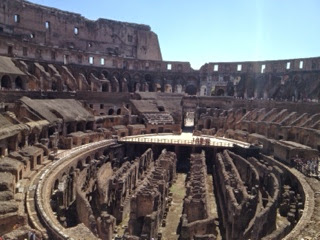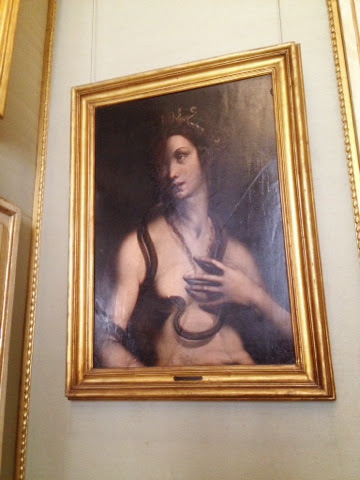Do I really have to go to Rome? Already planning how to return to Tuscany, I watch the Mediterranean fall away. Too soon, we reach Orbetello for our final European train journey.
Wound down almost to a stop, I don't quite feel ready for the "big city." And Rome's Termini is big...mid-twentieth-century modern set against ancient stone walls. Already I feel the power of this monumental city. And we only have two and a half days to explore her.
Where shall we begin? I ask Alessandra, presiding in quiet elegance at the front desk of our gracious hotel, Albergo del Senato. "Walk," she replies firmly. I nod, as this is my favorite way of discovery. But I am not prepared for the majesty that surrounds me. Just outside our hotel's entrance is the Pantheon, stark and grand.
Every turn of the corner is gasp-inducing. I can only marvel at the Piazza Navona, a vast space once constructed for foot races. People hang out around its Bernini fountains, everyone drawn by the square's quirky charm.
Instead of feeling oppressive, though, Rome is welcoming, relaxed and easy. And her beautiful people, so dignified, so warm. (Even, I will see later, at airport security!) Is there another city that combines overpowering scale with such warm intimacy?
Our first afternoon is spent wandering...mouth open in awe at the grandeur - the immense and tiny squares, fountains, churches. These great doors are inside St. Agnes' church at Piazza Navona, built as the family chapel of 16C Pope Innocent.
The next morning we head to the Coliseum, on the top of my companions' lists. Why? I'd asked. Isn't it just an amphitheater? Yes, it is. THE amphitheater. A place of such scope and power it takes your breath away.
Inside, there is a wonderful exhibit on libraries across the ages. I am struck by the reminder that we didn't always have punctuation and capital letters to point our reading way. The ancients had to roll and unroll long scrolls of handwritten, unseparated words. Then in the first century AD, the Romans invented the codex, the bound book as we know it...one of their greatest contributions to mankind.
Later we buy Hop On, Hop Off bus tickets from a charming Ethiopian vendor near the base of the original Arc de Triomphe.
Before boarding, we bargain for Roman fedoras, feeling a little silly, but who cares? It's a party atmosphere all over town.
Sitting on the open-air top level, we are glad for the sun protection. Here we get the most staggering views. Across the Tiber River...
To the balcony where Mussolini would address the people.
The evenings are lively, people strolling and hanging out, every square and corner spilling over with outdoor restaurants. We enjoy delicate thin-crust pizza - and more perfect pasta, made as only the Italians can. Divine.
Our last day it's back to the streets, more wandering, marveling, shopping - sandals and boots - and gelato-eating. This summer I've been favoring the fruit flavors, plum, peach, and berries. This time I have mango. My husband sticks with his tried and true chocolate and coffee. You can't go wrong.
That afternoon, we visit the spreading Borghese Gardens en route to the Borghese Galleria. Like the Medicis, the family grew rich during the Renaissance and built stupendous art collections, assisted by well-connected relatives in the Vatican. We must be grateful to the Cardinal Scipione Borghese, patron of Caravaggio and Bernini.
I marvel at the Bernini sculptures, each a little tableau that draws you in...characters of myth brought to life with such skill. The artist was only twenty-three when he completed the Rape of Prosperina.
Look at the hands and how the flesh gives.
And this Bernini foot, real toes.
I love this seductive Cleopatra, complete with snake.
In this unusual Caravaggio work, young Jesus is shown subduing the serpent. He is pictured with his mother (in a revealing bodice) and grandmother, St. Anne (revered in Islam and the Eastern Orthodox church as Hannah).
And look at Jesus reaching out, so physical and real, such a need to connect.
The sumptuousness of the space stuns me...the immense rooms with marble and brocade walls, towering ceilings, frescoed domes...
Here is a close-up of the cute little angel flying his kite.
I am smitten with this woman, captured in a timeless floor mosaic from the Roman period.
And how about this Canaletto painting of the Coliseum?
That night we celebrate my husband's birthday at an easy-going restaurant we've discovered near Piazza Navonna - Fattoincasa, a real local spot, a hotel staffer tells me approvingly. Of course the pasta is perfect, fresh broad tagliatelle with pepper and pecorino cheese - cacio e pepe - but so is the friendly atmosphere. Afterward, we stroll back through Navonna, where festive crowds continue to celebrate the joys of a warm Roman evening. As they have over the ages.
The centers of empire have shifted, but Rome endures. Italy endures, captivating our hearts and souls. Utterly seduced by this magical country, I am already planning my next visit.
With an early flight (no more trains, this time around), we wake up early to this...
Arrivederci, Roma. It's a date.



































































